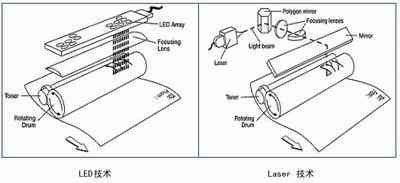A few days ago, Lexmark introduced a Lexmark C910 color laser printer with an LED engine. A3 format color printing is available, color and black and white printing speeds are up to 29 pages per minute, and the first page printing time is less than 15 seconds, claiming to be the world's fastest color laser printer.

Light-scanning imaging technology for LED full name Light Emitting Diode / LED array. A dense LED array is used as a light emitter, and the data electrical signal is converted into an optical signal by the LED and irradiated onto the photosensitive drum for imaging. As can be seen from the following figure: The LED printer is also an electronic imaging printer, using a set of light emitting diodes (LEDs). Instead of lasers for photographic imaging. The light-emitting diode is a semiconductor that emits light when it is energized. Each point of the imaging surface corresponds to a light-emitting diode. The main feature of the technology is that the LED light source is small in size, the light transmission distance is short, and is not limited by mechanical transmission. LED array imaging The system is small in size.
In principle, both LED technology and Laser technology require the generation of latent images on the imaging drum. The difference is that the Laser technology is a laser beam emitted by the laser. The rotation of the prism and other mechanical means is that the laser beam moves in the axial direction of the imaging drum. The rotation of the imaging drum itself causes the laser beam to be in the radial direction of the imaging drum. Move to form a two-dimensional latent image corresponding to the actual image. The LED technology is that the corresponding light-emitting diode illuminates the imaging drum, is imaged in the axial direction of the imaging drum, and is imaged in the radial direction of the imaging drum by the rotation of the imaging drum itself to constitute a two-dimensional latent image corresponding to the actual image.
If the diameter of the LED is continuously reduced, the resolution (ie, the print resolution) can be continuously increased, and the print speed is not slowed down while the print resolution is increased. More importantly, the LED color printer is based on the imaging principle of the LED, which can realize the one-time (simultaneous) imaging of the color image and complete the one-time printing of the color file. These two factors make LED printing speed, especially color printing, faster than printers using common Laser technology. In the printer of Laser technology, the printing resolution is improved, the laser beam emitted by the laser hair is increased on the imaging drum, and the printing speed is slowed down within a certain range. However, at present, in the Laser printing technology, there is a new 4-2-1 print engine, which also realizes one (simultaneous) imaging of color images, and the functions of color printing and black and white printing are the same.
However, in the LED printing technology, the printing resolution has a strict relationship with the hardware of the LED, and the improvement of the resolution requires the LED element itself to be made smaller and more difficult. Laser technology can now easily use some technologies, such as laser pulse modulation technology. The size, shape and position of the pixels can be varied by adjusting the wavelength and amplitude of the laser arrester pulses. For example, HP's FastRes 1200 technology allows users to print high-quality text and images close to 1200dpi using a 600dpi laser print engine. Epson's 600 dpi Color Scale Expansion Technology II (AcuLaser Color 2400) also allows users to print high quality text and images close to 2400 dpi using a 600 dpi laser print engine.
In terms of printing effect, LED technology can only use pulse modulation technology from the direction of one axis. Therefore, the printing result is relatively obvious relative to the particles, the color transition is not smooth, and the laser technology adopts two-dimensional control to obtain better and evenly transitioned colors. .
At present, the mainstream technology of laser printing is Laser technology, which is used by most manufacturers. Only OKI has always insisted on LED technology on laser printers. FUJITSU, CASIO and Lexmark also have some products that use this technology, but the market share is very low. But in any case, LED technology has its strengths and characteristics, and the laser printer that users choose which technology can choose according to their own needs.
(Assistant editor: xiaohu)
GPS Vehicle Tracker,Vehicle Tracker,GPS Motorcycle Tracker
OBD2 Vehicle GPS Tracker,GPS Vehicle Tracker,GPS Motorcycle Tracker Co., Ltd. , http://www.cn-gpstracker.com
![<?echo $_SERVER['SERVER_NAME'];?>](/template/twentyseventeen/skin/images/header.jpg)